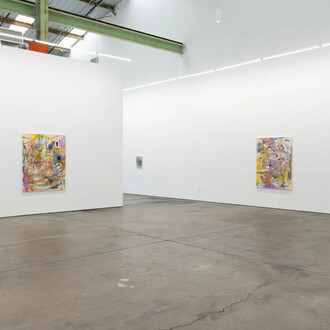At the crux of teetering climate tipping points and mass extinction, widespread ecocide unfolds in the Amazon Basin. Employing his distinctive documentary approach, Richard Mosse travelled to Rio Tigre in the remote northeast of Peru to document oil spills seeping from abandoned pipeline infrastructure on Kichwa Indigenous Territory, deep in the forest.
A multinational mining company drilled wells in this area in the 1970s, allegedly without adequate consultation with the Kichwa community, transporting the oil to the Pacific coast along hundreds of miles of pipeline. This infrastructure was abandoned fifty years later in 2015, yet the corroding pipes were never maintained or dismantled, and numerous oil spills and toxic swamps have begun to appear, contaminating the forest and rivers with heavy metals. It is the same in neighboring Indigenous territories, who have allied to advocate for compensation and a government assisted cleanup.
While many of these oil spills have been discovered by the Indigenous communities whose lands they pollute, others remain lost in the undergrowth in uninhabited parts of the forest. Inaccessible by foot, these spills can be located using Geographic Information Systems (GIS) imaging techniques, which analyze data gathered by multispectral camera sensors carried by remote sensing satellites that monitor earth from space. While a small group of scientists have employed this technique in recent years to locate oil spills along disintegrating pipeline infrastructure, they remain largely undiscovered and forgotten.
GIS imaging techniques are also used widely in the Amazon Basin by mining and agribusiness interests, to locate rare earth minerals, improve crop yield, or “see” the world in terms of resource extraction. Mosse’s employment of multispectral camera techniques brings both the medium’s inherent extractive violence and its potential to reveal environmental degradation to bear on this subject, unveiling oil pollution on Kichwa Territory in unflinchingly aesthetic and expressive ways. Mosse presents documentary evidence of the crisis facing the Kichwa community with a gaze that points to extraction and environmental politics, while highlighting the fact that their situation remains unseen.
Alongside these photographs of environmental catastrophe on Indigenous land, Mosse carried out a broader examination of the Western nature-culture dichotomy at play in the Amazon. Using the same photographic technology, he began photographing domesticated plants within the homes, workplaces and public spaces of people living in the Brazilian city of Belém do Pará, a tropical city at the gateway to the Amazon with a rich blend of cultural influences. In the context of wholesale deforestation, near and far from the forest’s urban centers, many people across the Amazon Basin regard plants with great reverence, revealing a special cultural affinity with nature.
Studied as a group, these portraits of domesticated plants show the ways in which nature is very often a focus for human desire, belief, and well-being, despite the forest’s mass destruction on an industrial level, sometimes only a matter of miles from where these photographs were taken.
Occidental offers a meditation on Western paradigms that separate nature and culture, one handed down to us from Aristotle and the Old Testament, which has traditionally placed humans and their culture outside of nature. Nature is variously understood as dangerous and in need of taming, colonizing, mastering, or destroying, or conversely as a pure or primordial space only existing in the absence of humans. The devastating consequences of ecological mismanagement by multinational oil companies on Kichwa lands is in stark contrast to their ways of living within nature, which is common among Indigenous peoples.
Meanwhile, the cultural veneration and domestication of plants seems antithetical to the forest’s widespread and normalized destruction, carried out by millions, yet may even lie at its roots.
The images in this exhibition were made using a monochrome digital sensor with a selection of narrow bandpass filters placed in front of the lens. Different exposures at specific points in the light spectrum were then overlaid in Photoshop and assigned a false color symbology. This process is also used in GIS imaging technology and was used by Mosse to create multispectral maps of environmental crime sites, two of which are included in the exhibition.
Mosse’s photographs of oil spills were facilitated by and on the invitation of PUINAMUDT, an alliance of Indigenous federations to advocate and protect their communities against hydrocarbon pollution. Mosse travelled to the Kichwa town of 12 de Octubre on the Rio Tigre. (12th of October is the date of Christopher Columbus’ discovery of the Americas.) The photographs of domestic plants were facilitated by and on the invitation of the individuals whose homes the plants inhabit.
This exhibition runs concurrently to the US premiere of Richard Mosse’s Broken Spectre, presented at Minnesota Street Project Foundation in partnership with SFMOMA. Broken Spectre is a dreamlike immersive video artwork documenting fronts of deforestation in the Amazon rainforest using a range of scientific imaging technologies. Shifting in scale and medium, the film takes a careful look at the processes involved in the destruction of the world’s largest tropical rainforest by agribusiness, logging, and mining interests – 99% of which, according to a recent report, are illegal.1 The film employs multispectral GIS techniques, as used in remote sensing satellites, reflective UV microscopy, and B&W 35mm infrared footage, to create a film that examines processes of the Amazon’s destruction through historic, activist, journalistic, and anthropological prisms, with reference to the Western and other iconography from the history of cinema. It was produced in collaboration with cinematographer Trevor Tweeten and composer Ben Frost.
Richard Mosse’s exhibition of new photographs, Occidental, will be shown at Altman Siegel, 1150 25th Street and the film, Broken Spectre, will be shown one block away at the Minnesota Street Project Foundation, 1201 Minnesota Street.
Richard Mosse (b. 1980, Ireland; based in New York) is an artist who has consistently documented historically significant subjects using photographic techniques that mediate and foreground elements of these narratives. Mosse’s subject matter is frequently charged and complex, employing unique technologies and collaborative approaches. Mosse seeks to heighten and extend the language of documentary photography to draw attention to overlooked yet urgent conflicts, often with a critical emphasis on the limitations of photojournalism, an activist’s sense of purpose, and a belief in the power of aesthetics to communicate, creating immersive and groundbreaking new forms in documentary photography and the moving image. He was awarded the Prix Pictet (2017), the Deutsche Börse Photography Prize (2014), and a Guggenheim Fellowship (2011). He earned an MFA in Photography from Yale School of Art (2008), a PG Dip in Fine Art from Goldsmiths (2005), an MRes in Cultural Studies and Humanities (2003) and a firstclass honors BA in English Literature and Language from Kings College London (2001). His work has been exhibited at the National Gallery of Art, the Barbican Art Gallery, Louisiana Museum, SFMOMA, the National Gallery of Victoria, Hamburger Kunsthalle, Akademie der Künste, MAST Foundation, the Victoria & Albert Museum, the Irish Museum of Modern Art, ICA Boston, and represented Ireland at the 55th Venice Biennale. He has published eight books, most recently a monograph of Broken Spectre, published by Loose Joints in collaboration with 180 Studios and Converge45, with texts by Hans Ulrich Obrist, Txai Suruí, Jon Lee Anderson, Christian Viveros-Fauné and others.
















